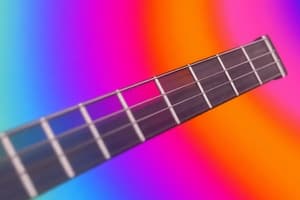Podcast
Questions and Answers
What is the fundamental characteristic of a major chord?
What is the fundamental characteristic of a major chord?
- The perfect fourth built on the root
- The major third built on the root (correct)
- The diminished fifth built on the root
- The minor third built on the root
Which notes make up a C major chord?
Which notes make up a C major chord?
- C-E-B
- C-D-F
- C-E-G (correct)
- C-G-B
In which inversion is the major third placed in the bass?
In which inversion is the major third placed in the bass?
- Third inversion
- Root position
- First inversion (correct)
- Second inversion
Which of the following intervals is considered stable and consonant above the major third in a major chord?
Which of the following intervals is considered stable and consonant above the major third in a major chord?
How do major chords generally affect the mood in musical compositions?
How do major chords generally affect the mood in musical compositions?
Flashcards
Major Chord
Major Chord
A musical chord built on the root, major third, and perfect fifth, creating a bright and consonant sound.
Root (Major Chord)
Root (Major Chord)
The first note of a major chord, forming its foundation.
Major Third
Major Third
The interval between the root and the third note of a major chord, creating its characteristic bright sound.
Perfect Fifth
Perfect Fifth
Signup and view all the flashcards
First Inversion (Major Chord)
First Inversion (Major Chord)
Signup and view all the flashcards
Study Notes
Major Chords
- Major chords are musical chords built on the principle of consonant interval relationships.
- The defining characteristic of a major chord is the major third built on the root.
- A major chord consists of three notes: the root, major third, and perfect fifth.
Construction of Major Chords
- The intervals within a major chord are:
- root to major third
- major third to perfect fifth
- The root is the first note of the chord, forming its basis.
- The major third creates a bright and consonant sound relative to the root.
- The perfect fifth completes the triad, providing a stable and consonant interval above the major third.
Common Major Chords
- C major chord (C-E-G)
- G major chord (G-B-D)
- D major chord (D-F#-A)
- A major chord (A-C#-E)
- E major chord (E-G#-B)
- B major chord (B-D#-F#)
- F# major chord (F#-A#-C#)
- C# major chord (C#-E#-G#)
Inversions of Major Chords
- A major chord can be inverted by putting any note (except the root) in the lowest position.
- First inversion: The major third is in the bass.
- Second inversion: The perfect fifth is in the bass.
Major Chords in Music Theory and Practice
- Understanding major chords is crucial for harmony in composing, arranging, and playing music.
Major Chords and Key Signatures
- Each major key has its own set of major chords.
Applications in Music
- Major chords are frequently used across musical genres for their bright and uplifting sound.
- They often evoke feelings of joy, peace, or optimism in music.
Studying That Suits You
Use AI to generate personalized quizzes and flashcards to suit your learning preferences.




